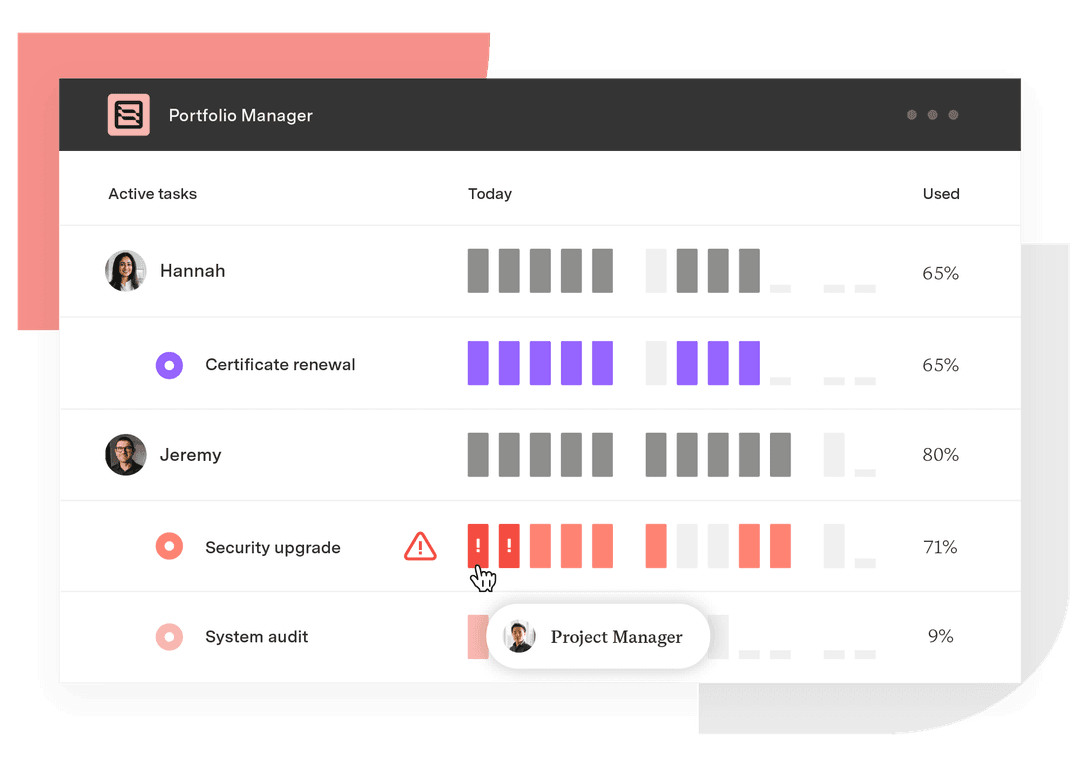Managing up: How to work effectively with your boss
Tempo Team
You don’t need to wait for your manager to notice how strong a worker you are to start earning recognition for your work. The key to advancing may lie in managing up – building a strong, collaborative partnership with your manager to open career doors and prove that you know what you’re doing.
Successfully managing up involves developing a relationship with your boss built on trust and proactive communication. It also shows that you’re willing to take initiative for the good of your team.
This approach creates a collaborative atmosphere where you and your manager can thrive. However, it's not always straightforward. Understanding when your efforts are practical, learning from feedback, and adjusting your approach are all part using this process to excel in your role.
What is managing up?
Managing up means proactively addressing concerns with your supervisor, such as flagging issues or proposing solutions before being asked. It also involves aligning your work with their expectations and goals to foster a positive and productive relationship.
Coordinating with – and even anticipating – your manager’s needs improves your performance and contributes to your career development, as your efforts drive both the team’s and organization’s success.
Managing up vs. managing down
Managing up focuses on collaborating with those in higher positions, while managing down pertains to leading subordinates. The key difference is the direction of influence: Managing up requires understanding and adapting to your manager's style and objectives, whereas managing down involves directing and motivating your team to achieve goals.
Examples of managing up in action
Here are some examples of managing up:
Proactive communication: An employee notices a potential issue in a project timeline and informs their manager promptly, proposing solutions to keep the project on track.
Understanding preferences: An employee realizes their manager prefers concise email updates and adjusts their workplace communication style accordingly.
Aligning with goals: An employee aligns their project objectives with the department's strategic goals, contributing to the company’s success and showcasing their strategic thinking.
How can managing up benefit you?
Managing up not only makes your boss’s life easier but has the potential to accelerate your career growth. Additionally, it:
Helps you navigate workplace dynamics
Every workplace has its own culture and unspoken rules. Managing means understanding and adapting to these dynamics. By paying attention to your manager’s feedback and preferred ways of working, you can tailor your approach to meet their expectations, making it easier for them to notice and appreciate your contributions.
Enhances leadership and decision-making skills
Even if you’re not in a leadership role, managing up strengthens the skills that define great leaders. Learning to anticipate needs and offering solutions to roadblocks or slowdowns rather than simply identifying problems develops leadership skills that serve you throughout your career.
Best practices for managing up
To effectively work with your boss, understand how they operate and how your work habits fit into that dynamic. Managing up involves recognizing work style alignment and using that awareness to improve workplace collaboration and efficiency.
Understand work styles and preferences
Knowing you and your manager’s work styles is crucial for effective communication and collaboration. By recognizing each other’s preferences, you can align your approaches, reduce misunderstandings, and work together more efficiently.
Get to know your boss’s work style
Observe how your manager organizes their workload. Do they plan far in advance or respond to things as they arise? Do they prefer written updates or process information better through conversation? The more you understand their work style, the better you can present information that resonates with them.
Get to know your work style
If you need clear instructions to work effectively but your boss is more hands-off, ask direct questions or propose a plan instead of waiting for guidance. Alternatively, if you prefer working independently but your boss likes regular updates, scheduling quick check-ins or performance reviews could prevent micromanagement. Identifying where your work habits align with your boss’s allows you to manage the relationship more effectively.
Communicate like your boss
Observe how your manager gives and receives information. If they keep emails brief and to the point, long explanations may not get the attention they require. Similarly, if they ask for detailed reports but you tend to summarize key takeaways, adjusting your communication style ensures your manager receives the information they need in the way they prefer.
Take initiative and build trust
Managing up demonstrates you’re trustworthy. When you consistently take initiative and seek feedback to improve, you position yourself as someone your manager can depend on.
Take initiative
Waiting to be told what to do limits your growth by preventing you from taking ownership, developing problem-solving skills, and showing initiative – key factors for career advancement. Instead, anticipate needs and propose solutions. For example, if you see a process that could be streamlined, suggest improvements. If your manager is overwhelmed, offer to handle tasks that align with your skills when you have bandwidth.
Be trustworthy
Reliability is the foundation of professional trust. This means being honest about challenges and following through on commitments. If something goes wrong, communicate early, focus on solutions, and avoid making excuses. A manager who knows they can depend on you is more likely to give you autonomy and opportunities for growth.
Be feedback-focused
Seeking and applying feedback shows self-awareness at work and a commitment to improving the team's success. Instead of viewing feedback as criticism, treat it as insight. Ask clarifying questions, implement suggestions, and follow up to show progress. Adopting a feedback-focused mindset promotes professional growth and signals your commitment to excellence.
Common pitfalls when managing up and how to avoid them
Managing up is essential for building a productive employee-manager relationship, but it’s easy to make missteps. Actions that seem effective in the short term can damage trust and credibility if they go too far. Here’s what to avoid and what to do instead.
Trying to manipulate instead of collaborating
Focusing on manipulating perceptions rather than improving outcomes (e.g., proposing solutions that only benefit you rather than considering the team’s needs) erodes trust, as people can usually spot self-serving motives.
What to do instead: Focus on genuine collaboration. Don’t try to control situations for personal gain, but find ways to align your strengths with your manager’s goals. Offer thoughtful solutions and build trust through reliability and thinking of the good of the team.
Covering up mistakes instead of addressing them
Hiding errors or shifting blame to avoid consequences might seem like self-preservation, but it can quickly backfire. For example, imagine you miss a deadline but don’t inform your manager, hoping to catch up without them noticing. If the mistake comes to light later, your credibility suffers. Even if the issue never surfaces, a pattern of avoidance can hinder your growth and prevent you from learning in your role.
What to do instead: Own your mistakes, communicate them early, and create a plan to fix them. A boss who sees you taking responsibility and working toward solutions is more likely to trust you.
Ignoring office politics completely
While office politics can be frustrating, ignoring workplace power dynamics may inadvertently undermine your success. For example, if you don’t realize that your boss relies on feedback from a senior finance colleague before approving budgets, you might submit your proposal without consulting them. This could cause delays or require revisions later. Managing up requires understanding how the company makes decisions and who holds informal and formal authority.
What to do instead: Pay attention to relationships and patterns within the organization. Who gives your boss key insights or approval before they make decisions? How does information flow? Understand these dynamics to navigate the workplace more effectively.
Know when to reevaluate
While managing up is valuable, it might not be enough to create a healthy, productive work environment. If your efforts to predict problems and offer solutions aren’t improving collaboration or the workplace’s culture limits your ability to succeed, it may be time to reassess the situation.
Recognizing when managing up isn’t working
Managing up requires mutual adaptability at work from you and your boss. If your manager resists input, disregards your efforts, or creates an environment where effective teamwork is impossible, continuing to adjust your approach may not be worth the effort. Signs managing up isn’t working include:
Lack of responsiveness: Your manager consistently ignores your efforts or suggested solutions.
Constant roadblocks: No matter how well you adapt, poor leadership or shifting expectations undermine your work.
Unreasonable demands: Your efforts to manage up are met with unrealistic expectations or a lack of support.
Evaluating whether your work environment is a good fit
Managing up can only go so far if you’re in a work environment that’s misaligned with your needs. To assess whether your current situation is a good fit, consider how well your values, work style, and long-term goals align with the organization. Ask yourself:
Does leadership support growth? Are there opportunities to advance and improve job satisfaction, or do you feel stuck despite strong performance?
Are your skills valued? Are your contributions recognized, or is your work overlooked?
Does the culture match your needs? If your workplace prioritizes long hours and rigid processes but you thrive in a flexible, innovative environment, this mismatch could hinder long-term success.
Is it an environment where you can learn? If you’re more knowledgeable than your boss, you may have limited opportunities for learning and growth.
Consider these factors to determine if your work environment supports your professional growth or if it’s time to make a change.
Collaborate better with Tempo
Tempo’s Strategic Roadmaps promote more effective managing up by promoting transparency and alignment between you and your manager. With all projects mapped out in a single, shareable view, it’s easier to demonstrate how your work contributes to broader company goals. It also builds trust with your manager by ensuring you’re on the same page, allowing you to communicate progress and challenges while preventing misaligned expectations.
Tempo also integrates customer feedback into Roadmaps, enabling you to prioritize projects based on real user needs. This data-driven approach shows your commitment to improving project outcomes and making decisions that align with your manager’s priorities and the company’s objectives.
By providing actionable insights, Tempo empowers you to drive greater impact and demonstrate strategic thinking in your work. Book a demo today.














































